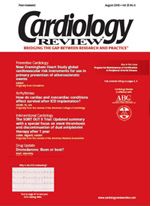Publication
Article
Cardiology Review® Online
Treating severe carotid artery stenosis in a patient with severe CAD: Insights from the SAPPHIRE trial
A 58-year-old man presented with a 6-week history of worsening of his chronic stable angina pectoris. He had known coronary artery disease (CAD), having had a myocardial infarction 8 years before presentation and, until recently, he had been successfully treated medically. He also had a history of deep vein thrombosis, hypertriglyceridemia, and pancreatitis. He had undergone percutaneous intervention to his left anterior tibial artery for lifestyle-limiting claudication 4 years before presentation and to his right anterior tibial artery 3 years prior to presentation. His other medical problems included hypertension and painful neuropathy. His medications included an analgesic, a beta blocking agent, an HMG-CoA reductase inhibitor (statin), an aspirin, and a fibrate with good control of his lipids, hypertension, and heart rate.
Because of the change in his symptoms he underwent cardiac catheterization. His ejection fraction was 55% and his coronary tree was heavily calcified. He had a complex bifurcation lesion involving his proximal left anterior descending (LAD) artery and a large diagonal with 70% narrowing of the diagonal and 90% narrowing of the LAD artery. His right coronary artery was totally occluded in the mid-segment with filling of a large posterior descending artery via collaterals from the left coronary artery. His circumflex artery had moderate diffuse disease. Given the angiographic nature of his lesions he was referred for coronary artery bypass grafting (CABG). He underwent routine carotid duplex ultrasound as part of his preoperative evaluation and was found to have a severe left internal carotid artery stenosis. Specifically, the ultrasound noted heterogeneous plaque from the origin to the proximal vessel with an 80% to 99% stenosis. The peak systolic velocity was 315 cm/sec with the end-diastolic velocity being 148 cm/sec and an internal carotid artery/common carotid artery velocity ratio of 5.62. Given the severity of both his carotid and coronary artery disease, it was decided to electively perform carotid artery stenting (CAS) to reduce his risk of stroke during CABG surgery. Accordingly, he underwent successful balloon an-gioplasty and stenting to the left internal carotid artery using emboli protection with an AngioGuard filter (Cordis, Figure). He had no procedural complications and was discharged from the hospital the day following the procedure. He was treated with aspirin and clopidogrel (Plavix) for 4 weeks. He subsequently was taken off clopidogrel and 2 months after undergoing his CAS underwent CABG with left internal thoracic artery graft to the LAD, saphenous vein graft to the diagonal, and saphenous vein graft to the posterior descending artery. He had no peri- or postoperative complications and went back to work 6 weeks after his surgery.
